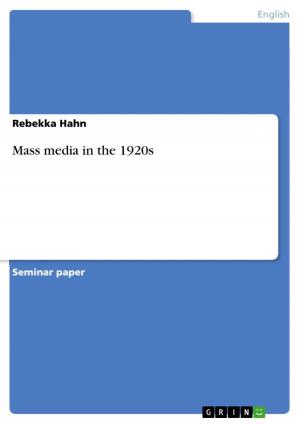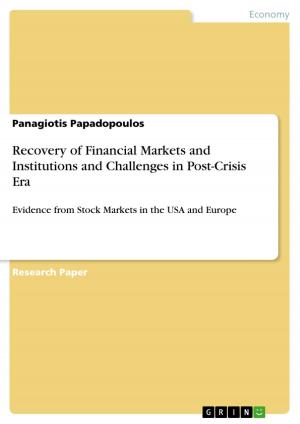| Author: | Alina Ignatiuk, Anton Pikus | ISBN: | 9783640297139 |
| Publisher: | GRIN Publishing | Publication: | March 25, 2009 |
| Imprint: | GRIN Publishing | Language: | English |
| Author: | Alina Ignatiuk, Anton Pikus |
| ISBN: | 9783640297139 |
| Publisher: | GRIN Publishing |
| Publication: | March 25, 2009 |
| Imprint: | GRIN Publishing |
| Language: | English |
Seminar paper from the year 2008 in the subject Business economics - Miscellaneous, grade: A, St. Mary's University San Antonio, Texas (Bill Greehey School of Business), 21 entries in the bibliography, language: English, abstract: Ukraine, the second largest state in Europe, appeared on the map of the world in 1991 after the dissolution of the Soviet Union. It borders Russia to the east, Belarus to the north, Poland, Slovakia and Hungary to the west, Romania, Moldova to the southwest, and the Black Sea and the Sea of Azov to the south. The capital of Ukraine is Kyiv. The state language of Ukraine is Ukrainian. Russian language is widely spoken, especially in the eastern and southern part of Ukraine. Although Ukraine has only been independent for seventeen years, it has an ancient history. In IX century the territory of Ukraine was a center of the East Slavic civilization, forming the state of Kievan Rus' which disintegrated in the 12th century [1]. At that period of time Kiev was the major political and cultural center in Eastern Europe. From the 14th century the territory of Ukraine was divided among a number of regional powers. As a result of such disintegration, in the 19th century the largest part of Ukraine was integrated into the Russian Empire, with the rest under Austro-Hungarian control [1]. In 1917 and 1918 three separate Ukrainian republics declared independence. However by 1921 the western part of the traditional territory had been incorporated into Poland and the larger central and eastern part became one of the founding republics of the Soviet Union. Later after the German and Soviet invasions of Poland in 1939 the western Ukrainian regions were also incorporated into the Soviet Union [2]. The Ukrainian national idea persevered during the Soviet period was pressed mostly by Stalin who imposed terror campaigns against the intellectual class. Ukraine declared its independence on Aug. 24, 1991 after the dissolution of the Soviet Union. It was quickly recognized by the international community and more then 100 countries have established diplomatic relations with Ukraine [3]. Ukraine is a big country with a population of 46.2 million inhabitants, 68 % of which are urban population [4]. Ukraine is considered to be in a demographic crisis because of its high death rate and a low birth rate (9.55 births/1,000 population and 15.93 deaths/1,000 population respectively, 2008) [4]. In Soviet times, the economy of Ukraine was the second largest in the Soviet Union, being an important industrial and agricultural component of the country's planned economy. [...]
Seminar paper from the year 2008 in the subject Business economics - Miscellaneous, grade: A, St. Mary's University San Antonio, Texas (Bill Greehey School of Business), 21 entries in the bibliography, language: English, abstract: Ukraine, the second largest state in Europe, appeared on the map of the world in 1991 after the dissolution of the Soviet Union. It borders Russia to the east, Belarus to the north, Poland, Slovakia and Hungary to the west, Romania, Moldova to the southwest, and the Black Sea and the Sea of Azov to the south. The capital of Ukraine is Kyiv. The state language of Ukraine is Ukrainian. Russian language is widely spoken, especially in the eastern and southern part of Ukraine. Although Ukraine has only been independent for seventeen years, it has an ancient history. In IX century the territory of Ukraine was a center of the East Slavic civilization, forming the state of Kievan Rus' which disintegrated in the 12th century [1]. At that period of time Kiev was the major political and cultural center in Eastern Europe. From the 14th century the territory of Ukraine was divided among a number of regional powers. As a result of such disintegration, in the 19th century the largest part of Ukraine was integrated into the Russian Empire, with the rest under Austro-Hungarian control [1]. In 1917 and 1918 three separate Ukrainian republics declared independence. However by 1921 the western part of the traditional territory had been incorporated into Poland and the larger central and eastern part became one of the founding republics of the Soviet Union. Later after the German and Soviet invasions of Poland in 1939 the western Ukrainian regions were also incorporated into the Soviet Union [2]. The Ukrainian national idea persevered during the Soviet period was pressed mostly by Stalin who imposed terror campaigns against the intellectual class. Ukraine declared its independence on Aug. 24, 1991 after the dissolution of the Soviet Union. It was quickly recognized by the international community and more then 100 countries have established diplomatic relations with Ukraine [3]. Ukraine is a big country with a population of 46.2 million inhabitants, 68 % of which are urban population [4]. Ukraine is considered to be in a demographic crisis because of its high death rate and a low birth rate (9.55 births/1,000 population and 15.93 deaths/1,000 population respectively, 2008) [4]. In Soviet times, the economy of Ukraine was the second largest in the Soviet Union, being an important industrial and agricultural component of the country's planned economy. [...]















